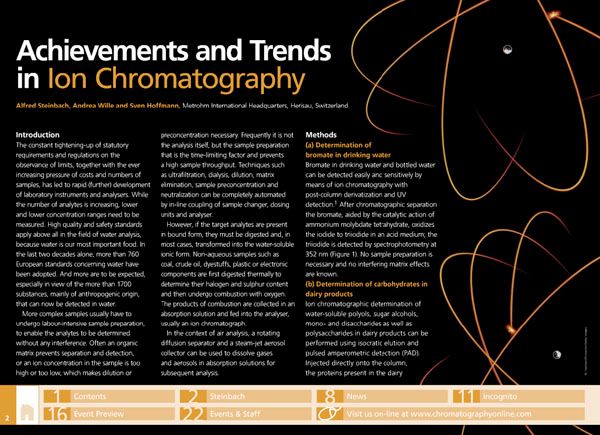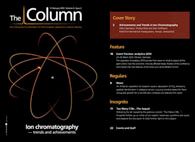Achievements and Trends in Ion Chromatography
This article considers some examples of uses of ion chromatography.
The constant tightening-up of statutory requirements and regulations on the observance of limits, together with the ever increasing pressure of costs and numbers of samples, has led to rapid (further) development of laboratory instruments and analysers. While the number of analytes is increasing, lower and lower concentration ranges need to be measured. High quality and safety standards apply above all in the field of water analysis, because water is our most important food. In the last two decades alone, more than 760 European standards concerning water have been adopted. And more are to be expected, especially in view of the more than 1700 substances, mainly of anthropogenic origin, that can now be detected in water.
More complex samples usually have to undergo labour-intensive sample preparation, to enable the analytes to be determined without any interference. Often an organic matrix prevents separation and detection, or an ion concentration in the sample is too high or too low, which makes dilution or preconcentration necessary. Frequently it is not the analysis itself, but the sample preparation that is the time-limiting factor and prevents a high sample throughput. Techniques such as ultrafiltration, dialysis, dilution, matrix elimination, sample preconcentration and neutralization can be completely automated by in-line coupling of sample changer, dosing units and analyser.
However, if the target analytes are present in bound form, they must be digested and, in most cases, transformed into the watersoluble ionic form. Non-aqueous samples such as coal, crude oil, dyestuffs, plastic or electronic components are first digested thermally to determine their halogen and sulphur content and then undergo combustion with oxygen. The products of combustion are collected in an absorption solution and fed into the analyser, usually an ion chromatograph.
In the context of air analysis, a rotating diffusion separator and a steam-jet aerosol collector can be used to dissolve gases and aerosols in absorption solutions for subsequent analysis.
Evaluating the Accuracy of Mass Spectrometry Spectral Databases
May 12th 2025Mass spectrometry (MS) can be effective in identifying unknown compounds, though this can be complicated if spectra is outside of known databases. Researchers aimed to test MS databases using electron–ionization (EI)–MS.
Detecting Hyper-Fast Chromatographic Peaks Using Ion Mobility Spectrometry
May 6th 2025Ion mobility spectrometers can detect trace compounds quickly, though they can face various issues with detecting certain peaks. University of Hannover scientists created a new system for resolving hyper-fast gas chromatography (GC) peaks.

.png&w=3840&q=75)

.png&w=3840&q=75)



.png&w=3840&q=75)



.png&w=3840&q=75)









